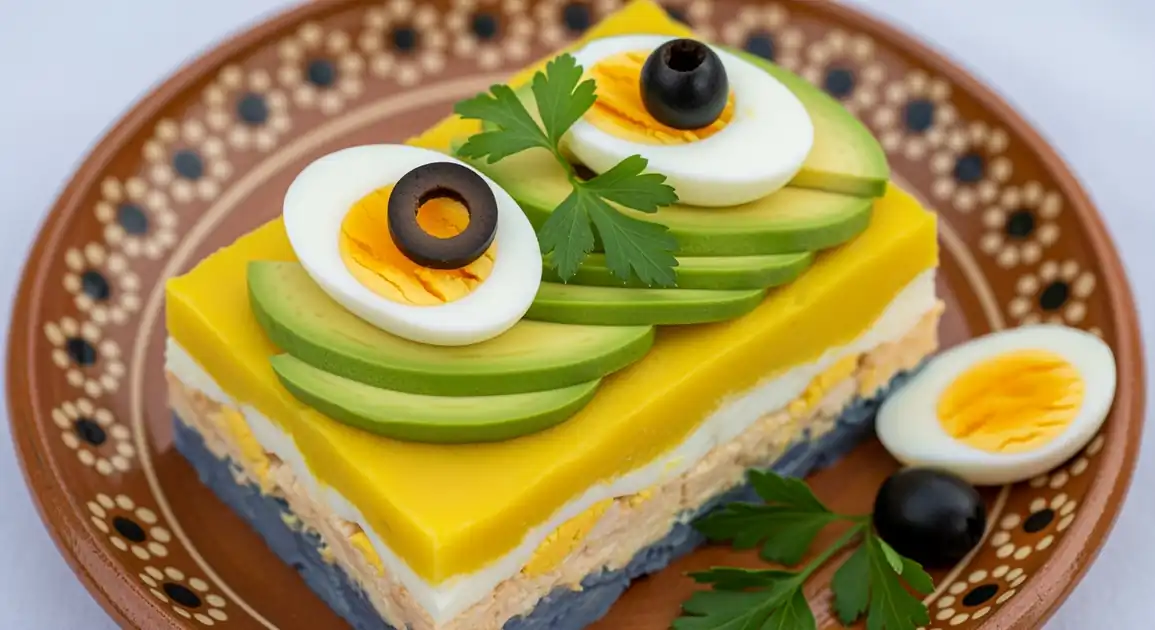Causa
Causa Limeña

Description
Causa is a beloved national dish found throughout Peru, symbolizing the country's rich agricultural heritage and culinary creativity. While traditional recipes are treasured, contemporary Peruvian chefs continuously reinvent Causa with new presentations and flavor combinations, making it both a comfort food and a canvas for gastronomic innovation.
Dietary Information
Serving information
Serving style
Typically served cold as an appetizer or light meal. Presented either as a slice from a larger terrine or as an individual molded portion. Usually accompanied by decorative garnishes, sometimes with a side of extra sauce.
Quick facts
Restaurants typically serve Causa during standard meal hours: lunch (12 PM - 3 PM) and dinner (7 PM - 10 PM). Market stalls usually operate from morning until mid-afternoon (8 AM - 3 PM).
Safety Tips
What to Look For
-
Proper refrigeration
As a cold dish containing mayonnaise and proteins, Causa must be kept refrigerated. Look for restaurants with proper cold storage.
-
Clean, organized preparation areas
Since Causa involves multiple ingredients and handling, kitchen cleanliness is important.
-
Fresh garnishes
Fresh-looking avocado, vibrant herbs, and properly cooked eggs indicate overall freshness.
-
Reputable establishments with high turnover
Popular restaurants ensure the ingredients don't sit too long before serving.
-
Proper separation from raw ingredients
In market settings, ensure Causa is prepared away from raw meats or seafood.
What to avoid
-
Causa sitting at room temperature for long periods
Due to mayonnaise content, Causa should not be left unrefrigerated, especially in warm weather.
-
Discolored or dried-out appearance
Browning avocados, darkened potatoes, or dried edges indicate it's been prepared too far in advance.
-
Strong or sour smell
Fresh Causa should have a pleasant, mild aroma. Any sour smell could indicate spoilage of mayo or protein fillings.
-
Cross-contamination risks
Be cautious of vendors handling money and food without washing hands or using appropriate utensils.
-
Very low prices at questionable establishments
Quality ingredients for Causa cost more; suspicious bargains might indicate cut corners on freshness or refrigeration.
Price information
Price range
Budget tips
- Local 'menú' restaurants (fixed price lunch spots) often include Causa as an appetizer option for 12-18 PEN.
- Market food stalls may offer simpler versions for 10-15 PEN.
- Avoid tourist-oriented restaurants where prices can be inflated without quality improvement.
- For value, look for establishments frequented by locals rather than those on main tourist routes.
Value indicators
- Generous portion size with substantial filling.
- Quality garnishes like fresh avocado and olives (not just a token amount).
- Distinct layers and careful presentation.
- Balanced seasoning with noticeable ají amarillo flavor.
- Accompanying sauce or additional garnishes.
Where to Find This Dish
City Center
Traditional restaurants and tourist-oriented establishments often feature Causa on their menus.
Plaza de Armas, Plaza San Martín
Lunch (12 PM - 3 PM), Dinner (7 PM - 10 PM)
Market Areas
Local markets sometimes have food stalls serving homestyle Causa.
Mercado Central, Local district markets
Late Morning (10 AM - 12 PM), Lunch (12 PM - 2 PM)
Coastal Districts
Seafood restaurants in these areas often specialize in seafood variations of Causa.
Miraflores coastline, Barranco seafront
Lunch (12 PM - 3 PM)
Vendor Tips
- Look for restaurants displaying their food ratings or certificates from health authorities.
- Restaurants specializing in 'comida criolla' (traditional Peruvian cuisine) generally make the most authentic Causa.
- In upscale restaurants, check if Causa is listed as a signature or recommended dish.
How to Order
Regional Variations
-
Causa Limeña
(Causa Limeña)
The classic Lima style, typically layered with chicken or tuna salad mixed with mayonnaise, and garnished with avocado, hard-boiled eggs, and olives.
-
Causa de Mariscos
(Causa de Mariscos)
Seafood version filled with a mixture of various seafood like shrimp, crab, or octopus, often with a touch of cocktail sauce.
-
Causa de Atún
(Causa de Atún)
Specifically featuring tuna mixed with mayonnaise, onions, and sometimes corn or peas as the filling.
-
Causa de Pollo
(Causa de Pollo)
Chicken-filled version, typically using shredded poached chicken mixed with mayonnaise and vegetables.
-
Causa Rellena Individual
(Causa Rellena Individual)
Individual portions shaped like small cakes or cylinders rather than a large terrine, often with more elaborate garnishes.
-
Causa Acevichada
(Causa Acevichada)
Modern fusion that incorporates elements of ceviche, often featuring raw fish cured in lime juice within or atop the causa.
Cultural context
History
Causa has deep patriotic roots in Peruvian history, with its name believed to derive from 'la causa' (the cause) during Peru's war for independence in the early 19th century. During this period, women prepared this potato-based dish to feed soldiers fighting 'for the cause.' However, its origins may date back even further to pre-Columbian times, as potatoes are native to the Andes. The modern version evolved in Lima, incorporating coastal seafood influences and European techniques to create the layered presentation that's now emblematic of Peruvian gastronomy.
Local significance
Causa represents Peru's agricultural heritage, specifically the importance of potatoes native to the Andes. Its name and history connect it to Peru's fight for independence, making it a dish with patriotic associations.
Eating customs
- Typically eaten as a starter before the main course.
- Appreciated for its visual presentation before eating.
- Often accompanied by an extra drizzle of lime juice or ají sauce according to personal taste.